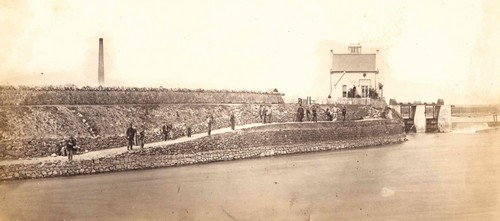Reconstruction of the Galway Fishery

by Tom Kenny
Based on the McMahon Report, a survey involving the engineers of the Commissioners of Public Works in consultation with local businessmen and anglers, works were undertaken to improve drainage, to facilitate navigation and to provide waterpower to the many mills in Galway. Waterpower was the bedrock on which the industry of Galway City was based and by the mid-19th century, there were some 30 mills in the city with associated headraces and tailraces which resulted in an intricate network of small waterways which greatly added to the charm of Galway.
The primary purpose in improving drainage was to reduce winter water levels in the areas of flooded land which was an ongoing problem. Winter water levels were reduced by 18 inches. It was an ambitious and extensive scheme which involved the construction of the Claddagh Basin, the locks on the Eglinton Canal and Parkaveara, dredging of channels of the Corrib, Gaol and Western Rivers and various tail races.
It involved the excavation of the river channel from the head of the canal past the West Bridge, construction of the Eastern Conduit, of the deep tailrace from the Newcastle Mill to the Marble Factory to discharge into the river at the rear of Persse’s Distillery. Also construction of culverts to allow tail races to run under headraces, a new pier known as Steamer’s Quay at Woodquay and the upgrading of mills to suit the new operating levels. Then there was the contentious construction of a salmon pass just north of the old weir.
The Ashworth family acquired the fishery while the construction was going on. In 1851, the old salmon weir was demolished and the new one built on the same site. Further upstream, the regulating weir was constructed & the river bed between the two was blasted and dredged to allow for the easier passage of salmon upstream and downstream. Another improvement was the inclusion of an ingenious device known as ‘a salmon ladder’ in the new regulating weir.
The Galway Express reported that 430 men and about 100 horses were involved in ‘the deepening of the river’, very welcome employment in the 1850’s. This project made a huge impact on the city and greatly benefitted the Fishery but also the various factories and mills in the vicinity by improving the flow of water, thereby making the point that the river was not there just for the benefit of anglers.
Our photograph today (which we found in France) dates from about 1875, some 20 years after the reconstruction of the fishery and shows how carefully the stone banks of the river were built up. The tall chimney in the background was part of the jute factory on the canal, where the College Bar is today. The regulating weir and salmon ladder can be seen just to the right of Fisheries House.
The Old Galway Society lecture season kicks off tonight in the Victoria Hotel with a talk by Professor Gearóid Ó Tuathaigh on “Galway through the eyes of Strangers, 1850 – 1914”. It starts at 8pm and all are welcome. Our thanks to Dr Jackie Ní Chionnaith for the above information.
